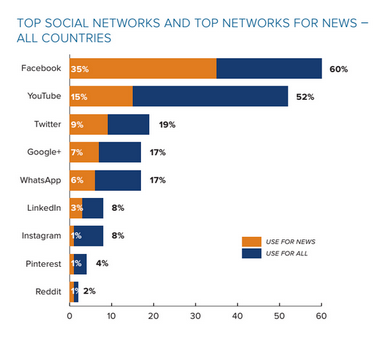The importance of the Facebook Newsfeed algorithm for publishers cannot be underestimated. Over the last couple of years we’ve seen a fundamental shift in people’s behaviour when hunting down news. In the past, getting news digitally was at least a semi-active affair. People would navigate to news websites manually, using bookmarks, typing the address in manually or coming from their own personal RSS readers. Nowadays over 35% of all people in the West use Facebook to get news.
Facebook has almost singlehandedly commandeered a shift in this behaviour from active to passive news discovery. Reminiscent of the days when ‘portal’ sites dominated the internet, Facebook is the world’s personalised portal. People will arrive at Facebook – the majority via a mobile app – and they’ll enter news websites via stories in their own personalised newsfeeds. News is actively served to you by Facebook, based on what it believes is interesting to you. It is not an exaggeration to say that Facebook has a significant effect on the news the world reads in the West.
How Facebook chooses what you see is based on many factors, but a crucially important one is how much activity the story is picking up…on Facebook, which is what we refer to as engagement. Let’s break down the different types of engagement that Facebook measures:
Visible Engagement:
On-post – Likes, Comments and Shares
Extended engagement – includes people sharing via the social share buttons on the publisher’s website, making comments into the Facebook comments box embedded in the publisher’s website, and people posting the news story to their walls, friends’ walls and even in FB chat.
Invisible Engagement – things that are counted but you can’t necessarily measure for other publishers.
Clickthroughs
Photo views – when you click to expand a particular photograph on Facebook.
Video views
Time spent observing the post
The last one is interesting as Facebook recently announced it publicly and detailed a little about how it works. Essentially it’s a relative measure that checks when you spend longer than usual observing an individual post. This now counts to a degree in the algorithm, so if a publisher were to post a photo that had everyone staring for several minutes, that photo has a greater chance of being served to more people organically and potentially going viral. It’s worth noting that Facebook doesn’t think this change should affect publishers in a major way.

Although that’s not to say it won’t change what you see. As we saw several months ago when Facebook began heavily favouring native Facebook video – viral sites that started maxing out on posting small auto-playing clips rose to the top rapidly. Expect any viral focused site to be making changes to test this algorithm change immediately.
In case you were wondering what the picture of two sunbathing girls was about, it was the the lead image in the busiest story on Facebook over the recent Midsummer break. Perhaps the recent algorithm change contributed to its success?



